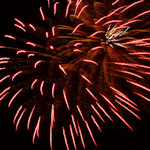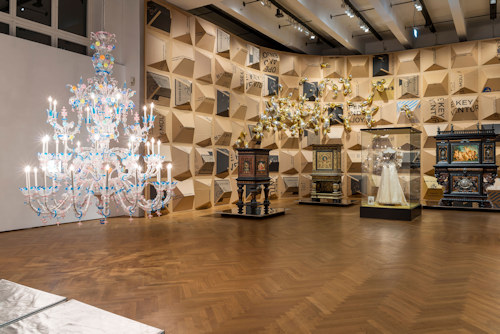
Recent times have not given us much to celebrate. But the THE FEST exhibition at the MAK offers a break from the toil of the 2020s with a look at the creativity and design behind celebrations through the ages.
- Covers the concept in its myriad of forms
- And art and design in a host of forms
- …clothing, jewelry, glassware, etc.
- Over 650 objects on display
- Texts in English & German
- Innovative exhibition presentation, too
- Runs Dec 14, 2022 – May 7, 2023
- See also:
Between representation and revolt

(MAK Exhibition View, 2022; THE FEST: Between Representation and Revolt; left: Cerith Wyn Evams, Astrophotography-Stages of photographic development by Siegfried Marx (1987), 2007; in the back: Peter Sandbichler, Corner installation, 2022; Patrick Rampelotto, Excess Wall, 2022; MAK Exhibition Hall © MAK/Markus Krottendorfer)
Look up the German word Fest in the dictionary and you’ll see translations like celebration, party or festival. The word fits with a medieval feast or a clubbing event. And all things in between.
What unites such occasions (and the participants) across time is an escape from mundane normality. And that puts us into a space built for creativity, as demonstrated in the exhibition, THE FEST.
It all begins with the exhibition design.
Austrian sculptor and visual artist Peter Sandbichler makes use of transformed bicycle cardboard boxes to create an evocative and unique exhibition environment: impressive art in its own right.
Then we have a veritable banquet of exhibits that take us from the strictures of formal occasions to the playful and subversive, from Baroque entertainments through to contemporary avant garde events.
A pot pourri “celebrating” creativity, excess and showmanship, pride and protest, the out of the ordinary, the fantastical, the transient and ephemeral, the imperial and the people.

(André Ostier, Vicomtesse de Ribes and Pierre Celeyron, Winter Ball, Hotel Coulanges, Paris, 30 December 1958; © A. & A. Ostier)
Consider it a masked ball of delights: step through the throng of themed galleries. Here a 16th-century brooch, there a pair of breeches made of Nivea tins. A multilayered dance through time and tastes.
We see creativity expressed in photos and posters, in chandeliers and champagne glasses, in clothes and centrepieces, in flyers and flags, in audio and video, in mirrors and masks and more.
Ah, yes, mirrors: expect quite a few which is a little unfortunate if you’re just about to turn 55 and might have had too much chocolate in recent months. Not naming any names.
The joy is in the variety, expertly curated by Brigitte Felderer and Olga Wukounig in cooperation with the MAK’s own Anne-Katrin Rossberg.
On the historical side, for example: 18th century porcelain table centrepieces or imaginary 17th-century designs for your sleigh festival.
Or a bronze replica from 186BC in the “Club culture” section banning the Dionysus cult. Or the remarkable Hall jewelry from the 1500s, once found on the wedding dress of Maria Christina of Austria (as we see in an oil painting of the time).

(Chug-glass for the Wiener Werkstätte, 1919; Design: Mathilde Flögl; Execution: Johann Oertel & Co., Haida/Nový Bor; Glass, painted; MAK, GL-3429; © MAK/Katrin Wißkirchen)
Or the colossal aquarelle cabinet from 1881 gifted to Archduke Rudolf and Princess Stephanie for their Habsburg wedding. Less a piece of furniture and more a monument to a dying institution. As if the wheel of time might be halted by an excess of ebony, walnut, and silver.
A slew of contemporary art and design fills the exhibition hall, too.
Close to that ancient anti-Dionysian notice, for example, you find leather shorts by Helmut Lang. Or a remarkably creative ball headdress made entirely of beer cans. Or a Venetian chandelier by Cerith Wyn Evans that lights in morse code.
Yet, as we slip forward in time, you begin to understand how the Fest often marked moments of historical transformation. And while the media and modes of expression change, the concepts and needs behind celebrations remain much the same.
Dates, tickets and tips
Enjoy the art and design of celebration from December 14th, 2022 to May 7th, 2023. Any ticket that gets you into the MAK also gets you into the exhibition.
The MAK has a fair few special treats on at any one time, like the Hagenauer Viennese metal art exhibition that runs concurrently with THE FEST and combines art, design, and history. So keep your eyes open for that and other special exhibitions.
For a more purely historical angle on the Fest, drop into the Silberkammer at the Hofburg palace complex. This Imperial Silver Collection is full of dinner services and other such delights that you won’t find on special offer at your local department store.
And should you wish to celebrate in style yourself while in Vienna, I fear I have no tips for you as I’m an old grump whose idea of a good night out these days is a cup of herbal tea on the sofa.
How to get to the MAK
Follow the travel tips at the end of the main MAK article for hints.
Address: Stubenring 5, 1010 Vienna